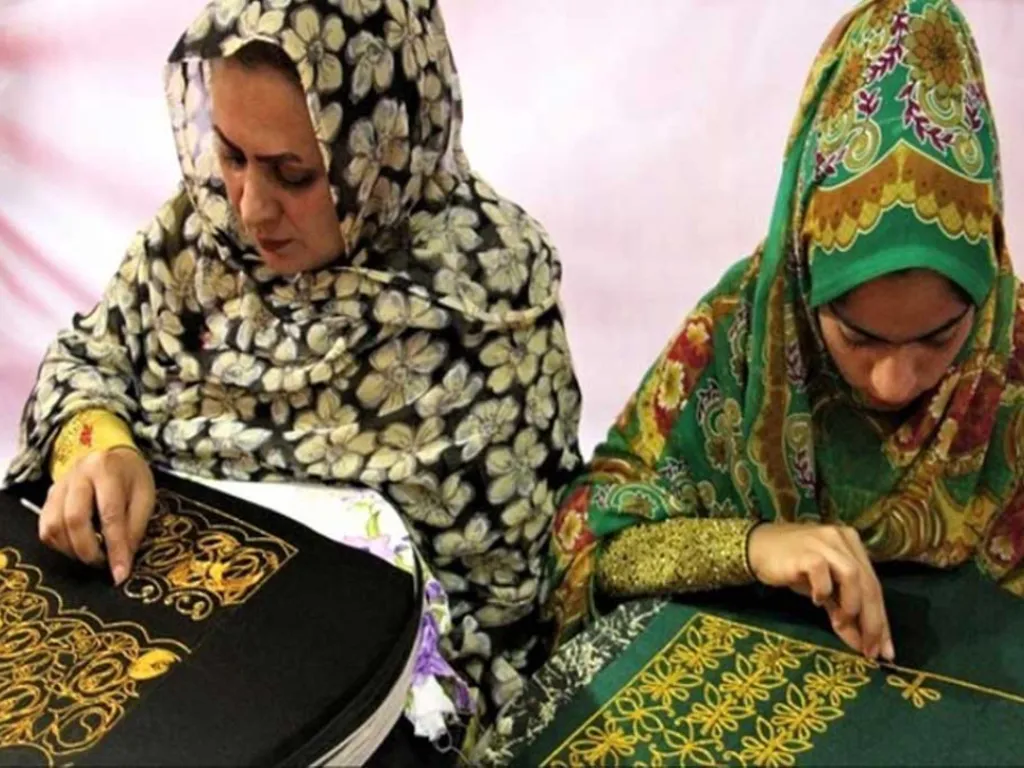
Local Clothes of Soheili
About Local Clothes of Soheili
The local clothes of the people of Soheili village in Qeshm are based on the customs and traditions of their region and are shaped by its available resources. Therefore, the traditional attire of this area, due to its location among the waters of the Persian Gulf and the frequent travels of Arab, Indian, and Iranian merchants and traders, has a strong resemblance to Indian and Arab clothing. Its gold embroidery (zaridozi) is inspired by the embellishments of Indian clothes, and the design of the clothing is similar to the attire of people in the UAE.
Interestingly, although the local clothes of Soheili village have a long history, they haven't lost their freshness over time and have preserved their cultural authenticity. This is because the people of this village still wear their traditional clothes as their main attire, and we see it evolving and becoming more attractive every day.
An Introduction to Qeshm's Local Clothes
The local clothes of Soheili village in Qeshm are a blend of design, color, and patterns, and can be considered a symbol of this region. The local attire is divided into two sections, men's and women's clothes, each consisting of several different parts. In this section, we will introduce you to each of these garments.
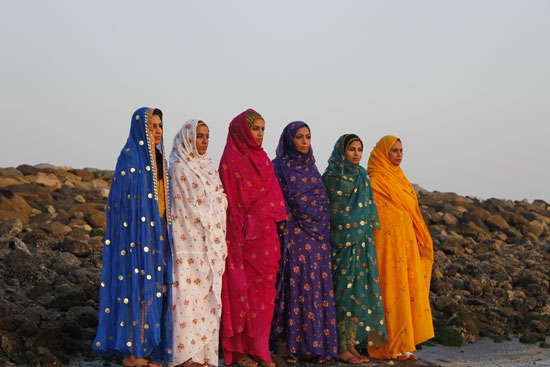
Qeshm's Women's Local Clothes, a Combination of Colors and Patterns
The local clothes of Soheili village are all handmade and are a blend of Indian, Persian, and African customs. This attire consists of several different parts: a garment called **kendour** or **kandoura**, trousers with special needlework, a colorful scarf called **leiso** (**leisi**), a traditional mask called **borqah** (**borkah**), and a traditional straw mat called **cheeda**. Some women add golden accessories to their masks to give them a special look. For wedding ceremonies, a soft scarf with a bracelet called "**jelouy**" is used instead of **leisi**.
The Kandoura Dress
The **kandoura** dress is the main garment for women in Soheili village, Qeshm. This dress is closed in the front and has a round neckline. The fabric is light and thin. Therefore, the **kandoura**, which is also called gandoura in Spanish, is adapted to the climate of this region and is usually sewn in warm and vibrant colors such as red, purple, green, fuchsia, pink, orange, yellow, and rarely turquoise blue.
It's interesting to know that this dress is common among the people of southern Iran, but the **kandoura** dress on Qeshm Island is more similar to the Arab dresses of the Persian Gulf countries, which is why it is sewn to be wider and longer.
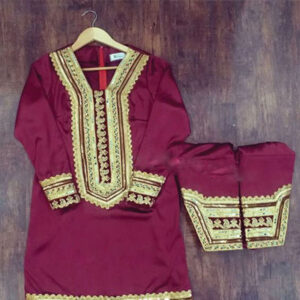
The Bandari Trousers
Another unique piece of clothing for women in Soheili, Qeshm, is a beautiful pair of trousers known as **Bandari trousers** or **dampa tang** trousers. These trousers have tight cuffs and are wide and diamond-shaped at the top. The top is usually fastened with an elastic band or a strong piece of fabric, and the cuffs are slit on the inside for easy wearing, then the slit is closed with a zipper or buttons.
These trousers have a similar shape and style throughout Hormozgan province, and what distinguishes them from each other is the type of decorations used on the trouser cuffs. The cuffs of **Bandari trousers** are usually decorated with various methods such as **badleh tamam**, **vodooei dasti**, **vodooei charkhi**, **poolaki**, **hashiehi**, **sarpa chehi**, **golabetooni**, **khoos langehi**, **vodooei atlasi**, and **nakhi**.
Bandari trousers are usually made from fabrics like tetron, poplin, and chintz, and for formal events and weddings, they are sewn with thick and embroidered fabrics such as atlas, zarbaft, and satin.
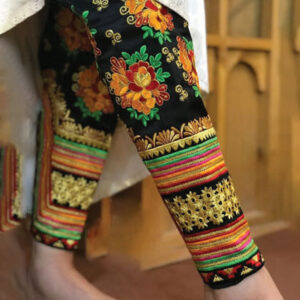
The Bandari Chador
Some women in Soheili village, Qeshm, prefer to wear a **Bandari chador** over their local clothes. This beautiful covering is made of thin and soft fabrics, mostly in brown, mustard, and grayish-blue colors. However, for new brides or during weddings, a green silk veil (**chador vil**) or a plain green sofa chador with **khoos**, **golabetoon**, and **poolak booteh-doozi** decorations is used.
Southern women wear the Bandari chador in two different ways: **La Nim La** or **Koul Zadan**.
- In the **La Nim La** method, one side of the chador is thrown over the shoulder, and the other side is left loose.
- In the **Koul Zadan** method, one side of the chador is wrapped around the head, and the other part is left hanging near the ear.
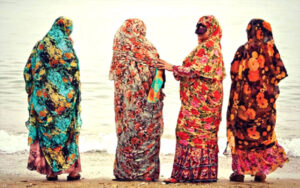
Orni
Orni is a type of silk scarf adorned with small and large flowers, boteh-jegheh, and paisley patterns. These designs are embroidered onto the silk fabric with various sequins and gold and silver threads. Southern women wear the Orni in a 'Kool' style, where they wrap one end around their head and let the other end hang over their chest.
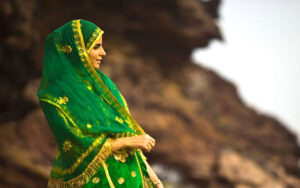
Borqa
The Borqa, or face-covering, is a type of decorative veil and hijab that women wear over their faces. This beautiful covering is not only religious but also has roots in the ancient culture of the people of the south and is one of the main parts of the traditional clothing for women in Soheili village, Qeshm. The Borqa comes in various styles, and southern women use different models depending on their situation. For example, single women use a black borqa, and engaged women use an orange one with sparkling designs.
- The oldest model of the borqa resembles a thick eyebrow or a man's mustache, which they place on their face to be mistaken for men.
- Another type of borqa is a rectangular covering. In this model, only the eyes are visible, and it protects women's faces from wind, sand, and sun.

Kamar Chin Dress
Some women in Soheili village, Qeshm Island, wear floral and colorful dresses according to their taste. These dresses are called Kamar Chin or Dor Chin and are sometimes seen with handmade collars and embroidered ribbons, or with woven gold threads from the market.
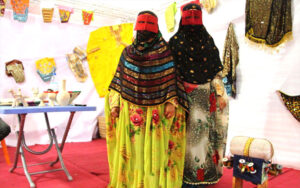
Traditional Attire of Men in Qeshm Island
The traditional clothing of Qeshm men consists of several different parts that men use depending on the situation.
Dishdasha
The Dishdasha is a long white garment that reaches the toes. This clothing comes in two types: with a collar and without a collar. The collared type is called the Iraqi model, and the collarless type is called the Gulf or Emirati model.
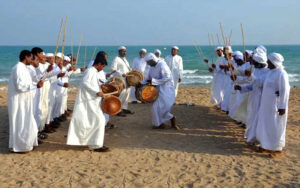
Lang
Due to the heat in Soheili village, Qeshm, men in this region used a covering called a Lang to take off their clothes to cool down or to prevent their clothes from getting wet with sweat. On the other hand, the Lang is also used for drying things and will prevent excessive sweating.
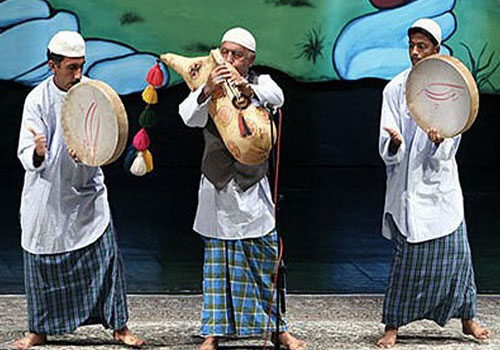
Jacket
Men in Soheili village, Qeshm, wear short jackets over their traditional clothes.
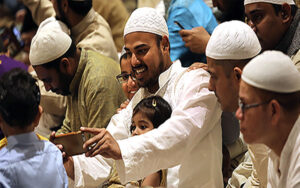
The traditional clothes of Soheili village, Qeshm, are derived from several different cultures, which makes them even more appealing. By traveling to this lovely island, you can still see its people in these clothes and experience their culture and customs up close.
You can even take the opportunity to wear the traditional clothes of this region, take beautiful pictures, and make your memories more lasting.
